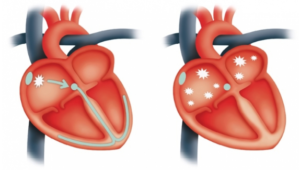 Atrial fibrillation, or A-Fib, is the most common type of irregular heartbeat (cardiac dysrhythmia). When left undiagnosed and untreated, the likelihood of experiencing life threatening complications can be extremely high. According to the Center for Disease Control, in 2018, A-Fib was mentioned on 175,326 death certificates and was the underlying cause of death in 25,845 of those deaths. It goes on to estimate that, based on current projections, 12.1 million people will have atrial fibrillation by the year 2030.
Atrial fibrillation, or A-Fib, is the most common type of irregular heartbeat (cardiac dysrhythmia). When left undiagnosed and untreated, the likelihood of experiencing life threatening complications can be extremely high. According to the Center for Disease Control, in 2018, A-Fib was mentioned on 175,326 death certificates and was the underlying cause of death in 25,845 of those deaths. It goes on to estimate that, based on current projections, 12.1 million people will have atrial fibrillation by the year 2030.
Circulation & The Heart
The human heart has four chambers – the right and left atria (the top two chambers), and the right and left ventricle (the bottom two chambers). Each chamber executes a perfectly timed squeeze and relax cycle governed by a specialized cardiac electrical system. Oxygen-poor blood enters the right atrium. The right atrium forcefully, and efficiently contracts, sending blood into the right ventricle. The right ventricle then contracts to send blood to the lungs for oxygen. This oxygen rich blood then enters the left atrium. A forceful and efficient contraction sends this blood to the left ventricle which contracts to send this oxygen rich blood to every organ and tissue in the body. After depositing oxygen, the now oxygen poor blood returns again to the right atrium and the whole process begins again. This is the process in a normally functioning, healthy human heart, and this occurs about 100,000 times per day, pumping five or six quarts of blood each minute, or about 2,000 gallons per day.
The Dangers of Atrial Fibrillation
What would happen if one or more of these chambers stopped functioning properly? If this perfectly synchronized process became disrupted. This is exactly what happens with atrial fibrillation. Atrial fibrillation is marked by rapid, irregular electrical activity in the atria, resulting in ineffective ejection of blood into the ventricles. Rather than forcefully and efficiently contracting, the atria quiver (fibrillate), resulting in severely compromised circulation, and all of the possible medical complications (some life threatening) that can result.
Possible complications include:
- Greatly increased risk for stroke – because the atria are not contracting properly, the blood that is not ejected can pool. This blood will begin to clot, and this clotted blood can then be forced through the system and lodge in the brain causing a stroke.
- Atrial Fibrillation with Rapid Ventricular Response (A-fib with RVR) – The normal heart rate for adults is 60-100 beats per minute. In A-fib with RVR, the ventricles begin beating too rapidly often causing heart rates well above 100. This is a true emergency, and immediate medical attention is required.
- Heart Attack – This can result from blood clot or from the unsustainable exertion of A-Fib with RVR.
- Heart Failure – With heart failure, the heart is not pumping enough blood to meet the body’s needs. With A-Fib, the heart muscle can become damaged over time causing the heart’s pumping efficiency to become compromised.
- Dementia – Insufficient and irregular blood flow/oxygen to the brain as a result of A-Fib is a contributing factor in dementia.
- Sudden Cardiac Arrest – The already malfunctioning electrical system of the heart can deteriorate to the point where any effective heartbeat is no longer possible.
Causes
Factors known to cause atrial fibrillation include:
- Previous heart attack
- High blood pressure
- Coronary artery disease
- Abnormal heart valves
- Structural Abnormalities of the Heart
- An overactive thyroid gland or other metabolic imbalance
- Medications, caffeine, tobacco, street drugs, or alcohol
- Lung diseases
- Previous heart surgery
- Viral infections
- Stress due to surgery, pneumonia, or other illnesses
- Sleep apnea
Signs & Symptoms
It is possible to have atrial fibrillation and not know it however, most patients report some of the following symptoms:
- Dizziness
- Difficulty breathing or shortness of breath, even at rest
- Chest discomfort
- Confusion
- Heart palpitations
- Syncope or near syncope (loss of consciousness/fainting)
- Sensation of the heart fluttering or pounding
It is also important to note that in some cases, atrial fibrillation occurs intermittently. This is known as paroxysmal atrial fibrillation. In this case there are alternating periods of A-fib and normal heart rhythm which are just as important to diagnose. If you experience, or have experienced, any of the above symptoms, we urge you to get screened for atrial fibrillation as soon as possible.
Are You at Risk?
Atrial fibrillation screening is recommended for all adults age 50 and over (the risk increases with age), and adults age 40 and over who have any of the following risk factors:
- Heart disease, heart failure, or heart defects
- Diabetes
- High blood pressure
- Obesity
- Family history of A-fib
- Hyperthyroidism
- Sleep Apnea
- Use of alcohol, tobacco, drugs, weight loss/diet supplements, or overuse of caffeine
Your Screening & What to Expect
The good news is that your atrial fibrillation screening is non-invasive, fast, easy, painless, and you will not be required to remove any clothing. The test we will be conducting is known as an electrocardiogram (EKG). You will be asked to lie on your back, EKG electrodes with adhesive pads will be attached to your wrists and ankles, and a reading will be taken of the electrical activity of your heart. A trained technician will review the readout and determine if atrial fibrillation, or any abnormality, was detected, and a test results letter will be sent to you. It will be recommended that you follow up with your primary care physician if necessary and that you repeat this screening annually (or more often at your physician’s direction) if you meet any of the above criteria or have any of the above-mentioned risk factors. If your EKG is positive for atrial fibrillation, please do not panic. You can expect your physician to prescribe an anticoagulant to reduce your risk for a blood clots and stroke, as well as medications to control your heart rate and rhythm.
It will also be recommended that you maintain a heart-healthy diet (low sodium, low cholesterol, high in fresh fruits and vegetables), and eliminate as many risk factors as possible. This can include quitting smoking, eliminating alcohol and caffeine, and losing weight. The point that we want to get across is that atrial fibrillation IS manageable, but early detection is vitally important in reducing the risk of life-threatening complications and permanent cardiac damage. If you meet any of the above-mentioned criteria, possess any of the above-mentioned risk factors, or have experienced any of the above-mentioned signs/symptoms, PLEASE have your atrial fibrillation screening done as soon as possible.
